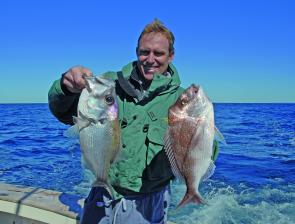The heavy rains through early winter have certainly given the offshore reefs a bit of a flush! I was out on the 50-fathom line in late June and even out there, over 30km from shore; the water was brown and murky.
The westerlies will in full force in August, but if you can strike a day of light winds the 36- and 50-fathom reefs will fire up for snapper and pearl perch. There have been some excellent pearlies around this winter with fish over 3kg relatively common. These fish eat squid, pilchards and soft plastics and are also very susceptible to heavy octopus style jigs such as the Lukanis models by Shimano. The lumo coloured Atomic shad, fished from a paternoster rig, has been one of the most effective soft plastics on pearlies recently. While targeting pearlies expect to catch a few pigfish, parrotfish and the odd big amberjack. All of these species love to feed near the big clumps of wire weed found on the 50-fathom line.
August can also be a good time to troll on the 50-fathom line. Yellowfin and striped marlin are more common this month than many locals are aware off, and trolling water depths of 80-100m or beyond can yield good fishing if the sauri schools are around. Troll lures between 20-30cm in length on 15-24kg tackle. It is hard to tell what is going to turn up at this time of year, but the gamefishing can be surprisingly good. Last year we caught a 160kg blue marlin in late July just out the back of the 50-fathom reef, so it pays to put out heavier tackle.
The 36-fathom line will produce plenty of squire and snapper, which have been fishing pretty well this season, with plenty of plate-sized 40-50cm fish caught. The 7” Gulp jerk shads seem to be the soft plastic of choice at the moment; on a recent trip the soft plastics caught as many fish as floating pilchards. Using a small stinger on a braid leader, run off the main hook, definitely increases squire catch rates.
In closer the cool water will begin shut down. Early morning sessions targeting snapper, mulloway and cobia are worth trying on the 18- and 24-fathom lines. There should also be some good tailor spinning in the back of the surf line. The water should be pretty clear if the westerlies blow and current should be minimal. For cobia try the 18-fathom bait reef directly east of the Seaway. The charter boats have caught some nice fish to over 30kg in the last month.
The reefs east of Tweed should produce some big yellowtail kings this month from the Nine Mile out to the 40-fathom line. Jigs, deep fished, live baits and soft plastics are all very effective. These kings tend to weigh in around 10-12kg this month with a few bigger amberjack amongst them. They are very tough to land when hooked on high reef patches. For their size, yellowtail kings definitely pull harder than amberjack or Samson fish. In my experience they are one of the strongest, hardest fighting species I have ever encountered.
The estuaries are in excellent condition, with plenty of bait around. Big schools of white pilchards have attracted large numbers of tailor and flathead into the Broadwater, and while the water took a long time to clear, the fishing has been quite good. The main target species this month is flathead, and they should increase in both size and numbers towards the end of the month.
Most of the flathead action has been towards the Seaway and Jumpinpin entrances, as the rivers were plagued with dirty water. Concentrate your efforts around the shallower weed bed fringes. Most fish are between 35-55cm at the moment, although the big spawning females will start to move towards the entrances at the end of this month. With predominantly smaller fish, 6-8kg leader should be sufficient for most flathead, but when the bigger models start to show it’s a good idea to upgrade to 10kg fluorocarbon.
There is a huge range of soft plastics that will effectively catch flathead, but the standard Squidgy Fish and Gulp minnows are as good as any I’ve tried. The best thing to do is pick lure you are confident with and stick to it, as success is generally more dependant on how you twitch or move the lure, rather than the lure itself. White, pink and chartreuse are proven colours. Don’t be afraid to use bright lures for flathead; if they see the lure earlier, they can line up their attack more accurately.
There have been plenty of good-sized tailor on the run-in tides around the Jumpinpin Bar at present and these should be active in August. Small metal lures cast to feeding schools are effective. The odd Australian salmon may also show up this month, they seem to be migrating further north every year.
Mulloway should be feeding in the deeper holes of the entrances and are worth targeting on tide changes on live baits and big soft plastics. Persistence is the key to catching decent jewies over 1m long. When fishing soft plastics don’t be too vigorous in your jigging action and strike at even the most subtle tap, big jewies often bite like sparrows.
Overall, August can be a cold and windy month on the water, but the days are getting longer now and the fishing is pretty good. For anglers fishing the upcoming Flathead Classic it is definitely time to start practicing and getting your techniques honed for the big event.
Reads: 5066
A big pearl perch taken from the 50-fathom line; pealies have been in great condition with winter.

An unusual catch – a flounder hooked on a soft plastic.

One of Australia’s great cricketers, Matt Hayden, is no slouch with a rod either, catching a squire and a pearly.




